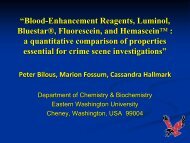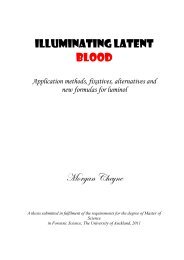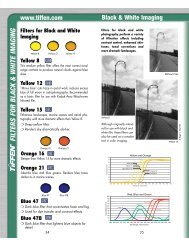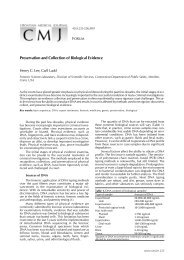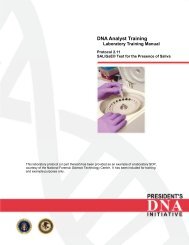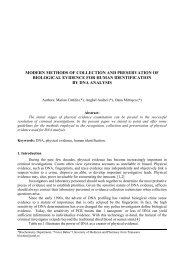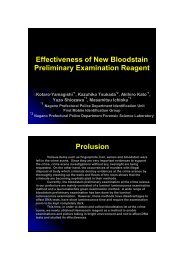Detecting Burnt Bloodstain Samples with Light-Emitting Blood ...
Detecting Burnt Bloodstain Samples with Light-Emitting Blood ...
Detecting Burnt Bloodstain Samples with Light-Emitting Blood ...
Create successful ePaper yourself
Turn your PDF publications into a flip-book with our unique Google optimized e-Paper software.
<strong>Detecting</strong> <strong>Burnt</strong> <strong><strong>Blood</strong>stain</strong> <strong>Samples</strong> <strong>with</strong> <strong>Light</strong>-<strong>Emitting</strong> <strong>Blood</strong> Enhancement Reagents<br />
American Academy of Forensic Sciences, 62 nd Annual Scientific Meeting, Feb 26, 2010<br />
INTRODUCTION<br />
Peter Bilous, PhD; Marie McCombs, BS; Matt Sparkmon, BS; Jenn Sasaki, BS<br />
Eastern Washington University (EWU), Department of Chemistry & Biochemistry<br />
226 Science Building, Cheney WA 990004-2440<br />
When criminals deliberately set fires or explosions to cover their activities, the resulting crime scenes<br />
are very difficult to process. Crime scene investigators are faced <strong>with</strong> the difficult task of locating,<br />
recognizing, and identifying biological evidence amongst the debris resulting from the fire or explosion<br />
(1). Biological and non-biological stains can appear similar when charred by the high temperatures<br />
associated <strong>with</strong> a fire or an explosion (2,3). Rapid and sensitive screening tests are required to assist<br />
the crime scene investigators <strong>with</strong> the task of selecting relevant biological material for subsequent<br />
DNA typing analysis.<br />
Forensic scientists use a variety of blood screening tests to detect the presence of blood at crime<br />
scenes (4,5). Typically, only the stains which yield a positive result <strong>with</strong> the blood screening tests are<br />
collected for subsequent DNA analysis. However, when the perpetrator had attempted to clean or<br />
remove blood evidence from a crime scene, sensitive light-emitting blood enhancement reagents can<br />
be employed to locate residual quantities of blood (6,7).<br />
Luminol is a very sensitive blood enhancement reagent which is widely used to detect trace quantities<br />
of blood at crime scenes (8,9). Another blood enhancement reagent, Bluestar®, uses a modified form<br />
of the luminol molecule to produce a very bright chemiluminescence-based blue-light emission<br />
(10,11). Both luminol and Bluestar® reagents have a short shelf life and must be prepared just before<br />
use. Furthermore, the crime scene must be darkened in order to see the short-lived light emissions.<br />
Hemascein TM is a fluorescein-based product which emits a fluorescence-based green light when<br />
excited <strong>with</strong> an intense blue-light source (12). One practical advantage of this reagent is the long<br />
shelf life of the working solution, several months when stored at refrigerator temperatures.<br />
Fluorescein, a blood enhancement reagent related to Hemascein TM , was shown to outperform both<br />
Bluestar® and luminol when used to detect burnt bloodstain patterns (3).<br />
A quantitative comparison of three different light-emitting blood enhancement reagents: luminol,<br />
Bluestar®, and Hemascein TM , was performed in this study in order to evaluate their ability to detect<br />
bloodstains which had been exposed to the heat and smoke of a fire.<br />
MATERIALS AND METHODS<br />
<strong>Blood</strong> <strong>Samples</strong>:<br />
• Canine blood was chosen for this study for health and safety reasons, and for its similarity to<br />
human blood in red blood cell count and hemoglobin concentration (13). Canine blood in<br />
Vacutainer® tubes <strong>with</strong> EDTA as a preservative was obtained from the Cheney Veterinary<br />
Clinic.<br />
• Serial dilutions of canine blood ranging from 1:10 to 1:10,000 were prepared using distilled<br />
water.
• Control bloodstain smears of approximately 1 cm 2 were prepared on glass microscope slides<br />
using 5 µl of a 1:10 dilution of liquid blood.<br />
• <strong>Burnt</strong> bloodstains were prepared using 5 µl of the 1:10 dilution of liquid blood and heat treated<br />
by direct exposure to the flame of an alcohol fire for 1, 3, or 5 minutes (Figure 1). <strong><strong>Blood</strong>stain</strong>s<br />
were subjected to temperatures ranging from 400-600 ºC.<br />
Figures 1a and 1b. Preparation of <strong>Burnt</strong> <strong><strong>Blood</strong>stain</strong>s: glass microscope slides <strong>with</strong> bloodstain smears<br />
were suspended face-down over a 10 cm diameter glass Petri dish filled <strong>with</strong> 10 ml of absolute<br />
ethanol for the burn experiment.<br />
<strong>Blood</strong> Enhancement Reagent Preparation:<br />
• Luminol was prepared according to the Grodsky formulation, modified <strong>with</strong> the addition of<br />
sodium hydroxide to a final concentration of 25 mM (10).<br />
• Bluestar® was prepared fresh by adding the two-prepackaged tablets to 125 ml of distilled<br />
water as per the manufacturer’s instructions (11).<br />
• Hemascein TM stock and working solutions were prepared according to the manufacturer’s<br />
instruction (12). For the purpose of this study, a test buffer was prepared just before use by<br />
mixing one part of the Hemascein TM working solution <strong>with</strong> one part of 3% hydrogen peroxide<br />
Emission Spectroscopy:<br />
• A Bio-Rad VersaFluor TM fluorometer was used to record light emissions. The intensity of the<br />
light emissions in Relative Fluorescence Units [RFU] was recorded every 7 seconds over the 5<br />
minute testing period.<br />
• <strong>Light</strong> emissions greater than 20,000 RFUs exceeded the instrument’s quantitation limit.<br />
• For blood tests <strong>with</strong> luminol and Bluestar®, the instrument’s excitation light source was<br />
blocked and a 460 ± 5 nm filter was used to measure light emissions.<br />
• For blood tests <strong>with</strong> Hemascein TM , a 460 ± 5 nm excitation filter and a 520 ± 5 nm emission<br />
filter were used.<br />
• For the analysis of liquid blood samples, a 25 µl aliquot of diluted blood was mixed <strong>with</strong> 2 ml of<br />
blood enhancement reagent in a UV-transparent plastic cuvette.<br />
• For the analysis of control and burnt bloodstain samples, individual stains were collected from<br />
the glass slide using a cotton swab moistened <strong>with</strong> distilled water. The collected stain was<br />
placed in a UV-transparent plastic cuvette containing 2 ml of blood enhancement reagent and<br />
mixed by inversion.<br />
• All blood tests were performed in triplicate and the results averaged.<br />
RESULTS AND DISCUSSION
Table 1. Summary of the maximum light emissions obtained for liquid blood, control bloodstains, and<br />
burnt bloodstains tested <strong>with</strong> luminol, Bluestar®, and Hemascein TM<br />
Sample & Test Conditions Maximum <strong>Light</strong> Intensity (RFUs)<br />
Sample<br />
Type<br />
Liquid<br />
<strong>Blood</strong><br />
Control<br />
<strong><strong>Blood</strong>stain</strong><br />
<strong>Burnt</strong><br />
<strong><strong>Blood</strong>stain</strong>s<br />
<strong>Blood</strong><br />
Dilution*<br />
Burn<br />
Time<br />
Luminol Bluestar® Hemascein TM<br />
1:800 -- 20,000** 20,000** 15004<br />
1:8,000 -- 18525 20,000** 5001<br />
1:80,000 -- 4368 9364 503<br />
1:800,000 -- 361 146 ND<br />
1:4,000 -- 20,000** 20,000** 11635<br />
1:4,000 1 min 481 11202 3957<br />
1:4,000 3 min ND 1128 2042<br />
1:4,000 5 min ND 785 867<br />
*Dilution values for blood in the test buffers<br />
** <strong>Light</strong> intensity exceeded instrument’s quantitation limit<br />
ND = Not detected or below 100 RFU (the light intensity which would not be visible to the naked eye)<br />
Liquid <strong>Blood</strong>:<br />
Figure 2. Intensity of light emissions obtained for liquid blood (1:8,000 dilution)<br />
• Liquid blood treated <strong>with</strong> luminol showed high and rapidly decreasing light intensity readings<br />
during the initial 60 seconds, followed by a more gradual decrease of light intensity.<br />
• <strong>Blood</strong> treated <strong>with</strong> Bluestar® gave the highest initial light intensity readings, decreasing rapidly<br />
during the initial 60 seconds, followed by a more gradual decrease of light intensity.<br />
• Although Hemascein TM light emissions were not as intense as Bluestar® or luminol during the<br />
initial 90 seconds of the test, the reagent’s light emissions were nearly constant over the entire<br />
5 minute test period.
• Similar results were obtained <strong>with</strong> other dilutions of liquid blood. See Table 1 for maximum<br />
light intensity values <strong>with</strong> other liquid blood dilutions.<br />
Control <strong><strong>Blood</strong>stain</strong>s:<br />
Figure 3. Intensity of the light emissions obtained for the control bloodstains (1:4,000 dilution)<br />
• As observed <strong>with</strong> the liquid blood samples (Figure 2), the light emissions obtained for the<br />
control bloodstains <strong>with</strong> Bluestar® were more intense than the emissions obtained <strong>with</strong><br />
luminol, <strong>with</strong> both reagents showing a decrease in light intensity beginning at approximately 30<br />
seconds for luminol and 120 seconds for Bluestar®.<br />
• The use of Hemascein TM resulted in light emissions which were not as intense as Bluestar® or<br />
luminol during the initial time period of the test, however, Hemascein TM light emissions were<br />
substantial and nearly constant over the entire 5 minute test period.<br />
<strong>Burnt</strong> bloodstains:<br />
Figure 4. Intensity of light emissions obtained <strong>with</strong> the bloodstain samples burned for 1 minute.
Figure 5. Intensity of light emissions obtained <strong>with</strong> the bloodstain samples burned for 3 minutes<br />
Figure 6. Intensity of light emissions obtained <strong>with</strong> the bloodstain samples burned for 5 minutes<br />
• Luminol produced detectable light emissions only <strong>with</strong> bloodstains subjected to a 1 minute<br />
burn.<br />
• Both Hemascein TM and Bluestar® had similar limits of detection, yielding significant light<br />
emissions <strong>with</strong> bloodstains subjected to a 1, 3, and 5 minute burn time.<br />
• In contrast to the light emissions obtained <strong>with</strong> Bluestar®, Hemascein TM light emissions were<br />
nearly constant over the entire 5 minute test period.<br />
CONCLUSIONS<br />
Our results show that the three blood enhancement reagents varied in their light emission<br />
characteristics, depending on whether the tested blood sample was a liquid, a stain, or a stain that<br />
had been exposed to very high temperatures of a fire.<br />
Both luminol and Bluestar® produced an intense chemiluminescence-based light emission <strong>with</strong> liquid<br />
blood samples during the first minute of the test. This was followed by a rapid decay of light intensity.<br />
In contrast, Hemascein TM produced a nearly constant fluorescence-based light emission <strong>with</strong>
intensities that equaled or surpassed those of Bluestar® and luminol after the initial one minute time<br />
period.<br />
Both Bluestar® and Hemascein TM outperformed luminol <strong>with</strong> respect to the detection of burnt<br />
bloodstains. Hemascein TM produced a nearly constant fluorescence-based light emission <strong>with</strong><br />
intensities that equaled or surpassed those of Bluestar® after the initial one minute time period.<br />
The above results suggest the potential benefit of using Hemascein TM to detect burnt blood at crime<br />
scenes. A study is in progress to optimize the Hemascein TM test conditions and analyze burnt<br />
bloodstains from simulated arson-homicide scenes.<br />
REFERENCES<br />
1. Bilous, P.T. and Goulden, R.J. DNA analysis of human blood recovered from explosion debris, in<br />
Bar, W., Fiori, A., and Rossi, U (eds.) Advances in Forensic Haemogenetics, 1994, 5:265-267<br />
2. Abrams, S., Reusse, A., Ward, A., and Lacapra, J., A simulated arson experiment and its effect on<br />
the recovery of DNA, Can. Soc. Forensic Sci. J., 2008, 41:53-60<br />
3. Tontarski, K.L., Hoskins, K.A., Watkins, T. G., Brun-Conti, L., and Michaud, A.L., Chemical<br />
Enhancement Techniques of <strong><strong>Blood</strong>stain</strong> Patterns and DNA Recovery after Fire Exposure, J. Forensic<br />
Sci., 2009, 54:37-48<br />
4. Lee, H.C., Palmbach, T., and Miller, M.T., Field Tests and Enhancement Reagents, in Henry Lee’s<br />
Crime Scene Handbook, 2001, pp 201-232, Academic Press<br />
5. Desroches, A.N., Buckle, J.L., and Fourney, R.M., Forensic Biology Evidence Screening, Past and<br />
Present, Can. Soc. Forensic Sci. J., 2009, 42:101-120<br />
6. Watkins, M.D. and Brown, K.C., <strong>Blood</strong> Detection: a Comparison of Visual Enhancement Chemicals<br />
for the Recovery of Possible <strong>Blood</strong> Stains at the Crime Scene, Evidence Technology Magazine, 2006,<br />
4(#2):28-32<br />
7. Tobe, S.S., Watson, N, and Daeid, N.N., Evaluation of Six Presumptive Tests for <strong>Blood</strong>, their<br />
Specificity, Sensitivity, and Effect on High Molecular-Weight DNA, J. Forensic Sci., 2007, 52:1-8<br />
8. Barni, F., Lewis, S.W., Berti, A, Miskelly, G.M., and Lago, G., Forensic Application of the Luminol<br />
Reaction as a Presumptive Test for Latent <strong>Blood</strong> Detection, Talanta, 2007, 72:896-913<br />
9. Quinones, I., Sheppard, D., Harbison, S.,and Elliot, D., Comparative Analysis of Luminol<br />
Formulations, Can. Soc. Forensic Sci. J., 2006, 40:53-63<br />
10. Blum, L.J., Esperança, P., and Rocquefelte, S., A New High-Performance Reagent and Procedure<br />
for Latent <strong><strong>Blood</strong>stain</strong> Detection Based on Luminol Chemiluminescence, Can. Soc. Forensic Sci. J.,<br />
2006, 39: 81-100<br />
11. Bluestar® Forensic Technical Application Note and User’s Manual, 2005, Roc Import, Monte-<br />
Carlo, Monaco www.bluestar-forensic.com<br />
12. Hemascein Technical Information Sheet, 2009, Abacus Diagnostic, Inc., West Hills CA<br />
www.abacusdiagnostics.com<br />
13. Lumsden, J.H., Mullen, K., and McSherry, B.J., Canine Hematology and Biochemistry Reference<br />
Values, Can. J. Comp. Med., 1979, 43:125-131<br />
ACKNOWLEDGEMENTS<br />
Dr. William B. Holleman, Cheney Veterinary Clinic, for the canine blood samples<br />
Abacus Diagnostics, West Hills CA, for trial kits of Hemascein TM<br />
Nicholas Brown, EWU, University Graphics, for the graphic design and printing of the poster<br />
Cassandra Hallmark, EWU forensic science student, for the determination of the burn temperatures<br />
Daniel Goodeill, Josh Lowry, and Breanna Badger, for their contributions to this work during their<br />
undergraduate studies in the Forensic Science program at EWU



